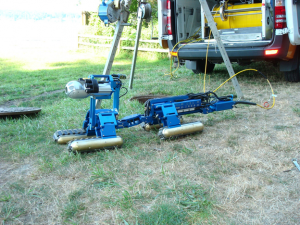February 2012, Vol. 67 No. 2
Features
Panoramic Pipe Inspection For Manholes

Panoramic pipe inspection technology has taken the process of inspecting sanitary sewer, storm sewer and water pipes to new dimensions, providing a 360-degree look at inside pipe surfaces and detailed information a step further past the capabilities of conventional pan-and-rotate inspection cameras and equipment.
Interactive Pipe Inspection (IPI) has been providing panoramic pipe inspection and assessment services for two years to engineers, municipalities and utility owners in the water and wastewater industries. Collected digital data is processed through various software applications and delivered in digital report format, along with a printed executive report and job summary.
The ability to provide engineers and municipalities with measurable data is a major benefit of the panoramic technology, said Bryce James, IPI manager.
“IPI’s pipe inspection system uses dual-mounted, high resolution cameras with wide angle lenses that can inspect pipelines eight-inches in diameter and larger at the rate of 14 inches per second,” James said.
Panoramic manhole inspections
Now IPI has brought the panoramic inspection process to manhole inspections, said James.
Until recently, James said, most manhole inspections have been made visually from the surface or by man entry, a time-consuming and dangerous confined-space task.
“IPI’s 360-degree manhole inspections speed the process by eliminating the need to take notes during visual inspections for use in preparing reports,” he said. “Data is collected at a rapid pace with pictures taken every two inches as the cameras move upward through the manhole. Typically a manhole inspection is completed in five to 7 minutes, making it possible for a crew to inspect many manholes in a work day.”

For manholes 16 inches and greater in diameter, IPI uses the Ibak Panaramo SI 3D Optical Manhole Scanner employing high-resolution digital cameras with specially designed, distortion-free wide angle lenses.
“The cameras optically scan the entire interior of the manhole in a few seconds in one single vertical run,” James explained. “The image data is transmitted digitally to the inspection van and is at the operators disposal as a live picture for orientation purposes and available as a panoramic ‘film’ of the whole manhole.”
On-the-spot analysis is possible, but most often assessments are made in the office by specialists.
“Unlike a video tape from a conventional pan and rotate camera which only shows the section of view saved at the time of taping, the Ibak Panaramo SI viewer software provides an all-round inspection of the manhole, just as if the inspector were on site with a pan and rotate camera,” said James. “At a desk with a computer and mouse, the user can stop at any position in the manhole, do a 360 degree pan, zoom, perform an image capture and complete the analysis data.”
Simultaneously, an unfolded view of the inner surface of the manhole can be generated which gives a rapid overview of the condition of the structure and enables the user to measure the position and size of objects with the aid of a computer.
Panoramic pipe inspections
For inspections of pipes eight inches in diameter and larger, IPI uses the 3D Optiscanner with thes Ibak Panaramo Rapid View camera inspection system also employing dual-mounted, high-resolution cameras with wide angle lenses. Parallel mounted xenon flashlights are triggered when cameras are activated. Scanned pictures are put together to form 360 degree spherical images. The scanning process can be accomplished both in forward and in reverse directions. As with manhole inspections, image data is transmitted digitally to the inspection van and is available to the operator and saved as a panoramic picture of the entire pipeline and viewer software permits in-the-office inspection of the section of pipe with the same capabilities described for utilizing manhole data.
For long-range pipe inspections, IPI uses the Inuktun VT300 Versatrax crawler/camera system with multi-sensor capability. The system is capable of inspections to distances of 7,000 feet, reducing logistics and deployment time.
“This system,” said James, “has three on-board video cameras with high-intensity LED lighting, can be outfitted with multiple sensors and can be used on round or flat surface applications at a speeds of up to 30 feet per minute. In pipe 12 inches in diameter and larger, sensors in addition to CCTV can be added. Laser scans are used to produce ovality and radius reports for sliplining. A sonar sensor typically is used for fully submerged pipes and siphons. However, underwater laser is one of the newest sensors for providing measurable data in fully-submerged pipes. H2S gas monitoring sensors can be combined in the same inspection, deployed on the same platform, and can be combined in the same inspection deployed on the same platform, and can provide multiple reports from the same footage location not visible to the human eye.”
Software
ITpipes software from Infrastructure Technologies (IT) provides comprehensive asset inspection management tools for water, wastewater and storm systems, including analysis and reporting, report visualization and distribution. IPipes GIS module allows planning and execution of projects using customer-supplied GIS maps.
Based in Turnwater, WA, Interactive Pipe Inspection was established in 2009 as a corporation specializing in advanced technology applications for the inspection of underground pipe systems to multi-national markets. IPI began as a division of Pipe Experts LLC, a leader in trenchless technology for more than 30 years, said James.
FOR MORE INFO:
Interactive Pipe Inspection, (800) 850-3053, http://ipi-pipe.com/




Comments